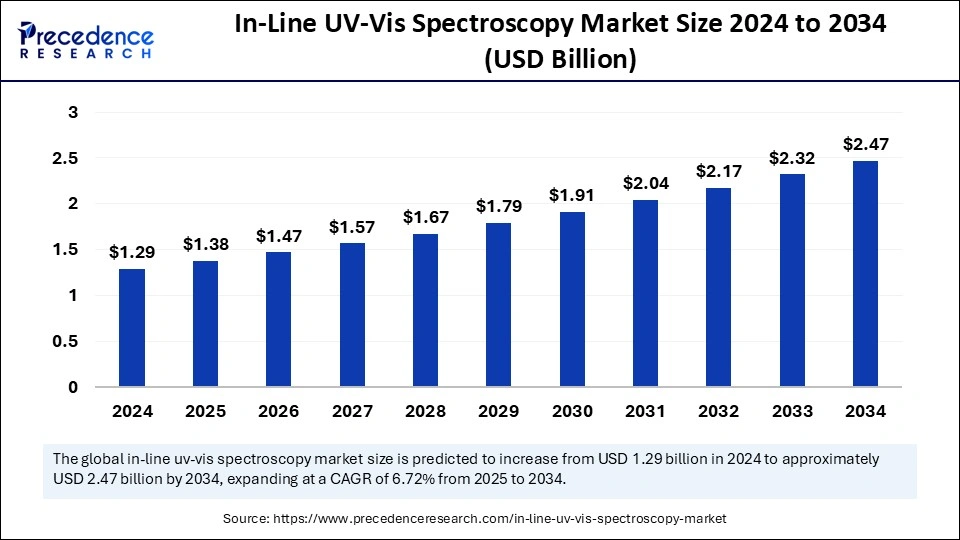The global in-line UV-Vis spectroscopy market is projected to grow from USD 1.29 billion in 2024 to USD 2.47 billion by 2034, at a CAGR of 6.72% from 2025 to 2034.

In-Line UV-Vis Spectroscopy Market Key Takeaways
- North America dominated the global market with the largest market share of 41% in 2024.
- Asia Pacific is expected to witness the fastest growth during the foreseeable period.
- By application, the color instrument segment contributed the highest market share in 2024.
- By application, the chemical concentration segment is expected to witness the fastest growth during the foreseeable period.
- By end user, the chemical industry segment is accounted for the largest market share in 2024.
- By end user, the painting and coating segment is expected to grow rapidly during the foreseeable period.
In-Line UV-Vis Spectroscopy Market Overview
The In-Line UV-Vis Spectroscopy Market is experiencing significant growth as industries increasingly prioritize real-time, non-destructive monitoring techniques for quality control and process optimization.
In-line UV-Vis spectroscopy is widely used in sectors such as pharmaceuticals, chemicals, food and beverages, and environmental monitoring, where it provides immediate insights into the composition, concentration, and behavior of substances. Unlike offline analysis, in-line UV-Vis systems are directly integrated into production lines, offering continuous data without the need for manual sampling. This approach improves efficiency, ensures consistency, and reduces operational costs, which are critical in highly regulated and high-throughput environments.
In-Line UV-Vis Spectroscopy Market Drivers
The market is primarily driven by the growing need for automation and process analytical technology (PAT) in manufacturing processes. Regulatory requirements in industries such as pharmaceuticals and chemicals demand real-time data to maintain compliance and ensure product safety. In-line UV-Vis spectroscopy supports these demands by enabling accurate monitoring of critical quality attributes.
Additionally, the adoption of Industry 4.0 technologies and smart manufacturing solutions has accelerated the deployment of integrated optical sensors for continuous monitoring. Companies are also looking to minimize waste and improve sustainability, which in-line monitoring helps achieve by optimizing resource use.
In-Line UV-Vis Spectroscopy Market Opportunities
There are expanding opportunities in biopharmaceutical manufacturing, where real-time UV-Vis spectroscopy is increasingly used to monitor protein concentrations, DNA/RNA purity, and enzyme kinetics. The integration of UV-Vis systems with cloud-based analytics and artificial intelligence opens new doors for predictive maintenance and enhanced process control.
The water treatment sector presents another promising opportunity as municipalities and private companies seek efficient ways to monitor contaminants in real time. Emerging markets in Asia-Pacific and Latin America are also showing increased interest in process automation, offering untapped potential for growth in these regions.
In-Line UV-Vis Spectroscopy Market Challenges
Despite the advantages, the market faces challenges including the high initial cost of equipment and the technical complexity of integration into legacy systems. Smaller manufacturers may find it difficult to justify the investment without a clear short-term return. Another obstacle is the need for skilled personnel capable of operating and interpreting spectroscopic data accurately.
Additionally, maintenance of in-line sensors in harsh production environments can be challenging, potentially affecting reliability and performance over time.
In-Line UV-Vis Spectroscopy Market Regional Insights
North America currently leads the in-line UV-Vis spectroscopy market due to its early adoption of process automation and the presence of major pharmaceutical and chemical manufacturers. Europe follows closely, driven by stringent environmental and safety regulations that encourage real-time monitoring solutions.
The Asia-Pacific region is expected to witness the fastest growth, fueled by industrial expansion, particularly in China and India, where demand for quality control technologies is on the rise. Meanwhile, Latin America and the Middle East are gradually integrating in-line technologies, mainly in the food processing and water treatment sectors.
In-Line UV-Vis Spectroscopy Market Recent Developments
Recent advancements in the market include the development of miniaturized and more robust in-line UV-Vis spectrometers that can operate under extreme temperature and pressure conditions. Companies are launching user-friendly interfaces and software solutions that simplify data analysis and system calibration.
Collaborations between spectrometer manufacturers and industrial automation companies are also on the rise, focusing on developing customized solutions for specific process needs. Additionally, innovations in fiber optic technology have improved the flexibility and efficiency of in-line sensor deployment in complex production environments.
In-Line UV-Vis Spectroscopy Market Companies
- Agilent Technologies, Inc.
- Shimadzu Corp.
- Thermo Fisher Scientific Inc.
- X-Rite
- ColVisTec AG Inc.
- Hunter Associates Laboratory, Inc.
- Applied Analytics, Inc.
- AMETEK, Inc.
- Guided Wave, Inc.
- Kemtrak AB
- Endress+Hauser Management AG
- Colour Consult
- Equitech Int’l Corp.
- Uniqsis Ltd
- Advanced Vision Technology Ltd.
Segments Covered in the Report
By Application
- Colour Measurement
- Chemical Concentration
- Turbidity & Haze Measurement
- Thickness Measurement
By End-User
- Plastics Industry
- Chemical Industry
- Food & Beverages
- Pharmaceutical Industry
- Painting & Coating Industry
- Others
By Geography
- North America
- Europe
- Asia Pacific
- Latin America
- Middle East and Africa
Ready for more? Dive into the full experience on our website!
https://www.precedenceresearch.com/
